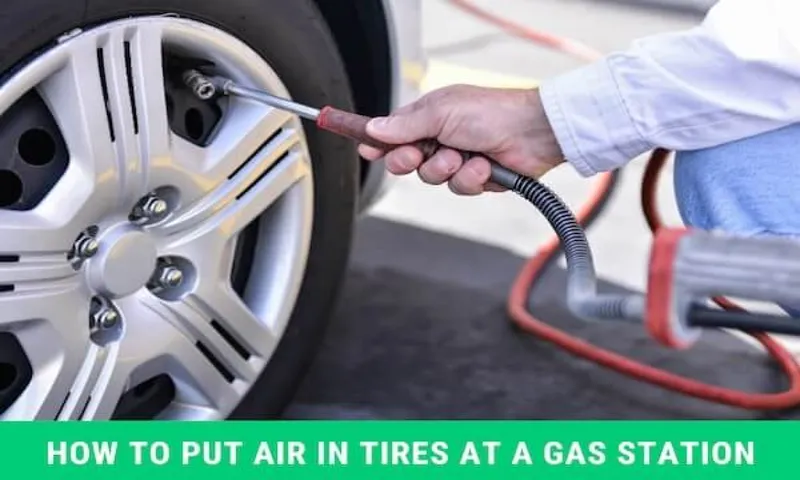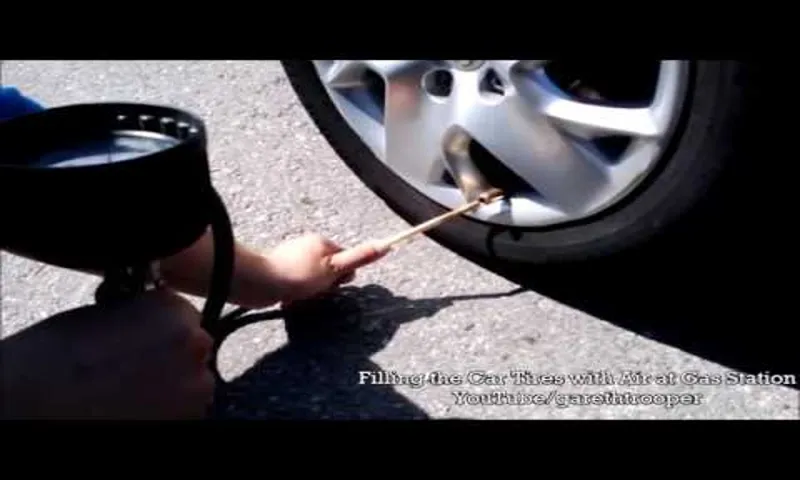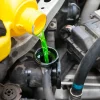Have you ever found yourself stranded on the side of the road with a flat tire? If so, you understand the frustration of not having your own air pump to change the tire’s pressure. Fortunately, almost every gas station has an air pump in case you run into this problem. However, for people who are not used to filling up their tires with air at gas stations, it can be quite intimidating.
Don’t worry, we’ve got you covered! In this blog post, we will discuss the steps you need to follow to fill up your tire with air at a gas station and get back on the road in no time. So, buckle up and let’s dive in!
Table of Contents
Gather Tools and Materials
If you’re driving on the road and notice that your tire is a bit low, it’s always a good idea to fill it up at a nearby gas station. Here are the steps on how to fill up a tire with air at a gas station. First, gather the necessary materials such as a tire pressure gauge and a tire inflator.
Make sure to check the recommended air pressure for your specific tire so that you don’t overinflate or underinflate it. Once you’ve collected your tools, locate the air pump at the gas station and remove the valve cap from your tire. Place the tire pressure gauge on the valve stem to check the current pressure.
Afterward, attach the tire inflator to the valve stem and turn it on. Inflate the tire to the recommended pressure, as indicated by the tire pressure gauge. Once it reaches the correct psi, turn off the inflator and remove it from the valve stem.
Finally, replace the valve cap and repeat the same process for all of your other tires. Remember to check your tire pressure regularly to ensure that your vehicle runs smoothly and efficiently.
Check the Tire Pressure
When it comes to checking your tire pressure, you’ll need a few tools and materials to get started. First and foremost, you’ll need a tire pressure gauge. These handy devices are relatively inexpensive and can be found at any auto parts store.
You’ll also need access to an air compressor or tire inflator, which can be found at most gas stations. Before you get started, it’s a good idea to check your vehicle’s owner’s manual to find the recommended tire pressure for your particular make and model. Once you’ve gathered everything you need, it’s time to get started.
Use your tire pressure gauge to check the pressure of each tire, making sure they are all at the recommended level. If any of the tires are low, use your air compressor or tire inflator to add air slowly, checking the pressure frequently until you reach the correct level. By keeping your tires properly inflated, you’ll not only improve your vehicle’s handling and fuel efficiency, but also extend the life of your tires.

Determine the Required Tire Pressure
When it comes to maintaining your vehicle, one of the most important tasks is checking your tire pressure regularly. Incorrect tire pressure can cause issues such as poor fuel efficiency and reduced tire lifespan. To determine the required tire pressure for your specific vehicle, you’ll need a few tools and materials.
First, you’ll need a tire pressure gauge, which can be purchased at most auto parts stores. Next, you’ll need to consult your vehicle owner’s manual or the tire placard located on the driver’s side door jamb. This will give you the manufacturer-recommended tire pressure for your specific make and model.
It’s important to note that the recommended tire pressure may vary depending on the type of tires you have installed. Once you have this information, you’re ready to check and adjust your tire pressure as needed. By taking the time to maintain proper tire pressure, you can ensure a smooth and safe driving experience while also prolonging the life of your tires.
Fill up the Tire with Air
One of the essential tasks in maintaining your vehicle’s safety and performance is keeping the tires inflated to the recommended level. If you need to fill up a tire with air and happen to be at a gas station, don’t worry, it’s a simple and straightforward process. First, park your vehicle near the air pump, ensuring that the tire you want to fill up is within reach of the air hose.
Check the tire’s recommended PSI (pounds per square inch) level, usually found on the driver’s side door frame or owner’s manual. Then, remove the tire valve cap and attach the hose nozzle securely onto the valve stem, pressing it in until no air escapes. Enter the recommend PSI level into the pump’s machine, and finally, push the power button to start pumping the air into the tire.
Once it reaches the appropriate level, the pump will automatically shut off, indicating that you’re done. Don’t forget to replace the valve cap and double-check that all tires are inflated to the correct pressure before hitting the road. Next time you need to fill up a tire, remember, it’s a quick and easy task that anyone can do with little hassle or frustration.
Park the Car at the Gas Station Air Pump
When it comes to maintaining your vehicle, taking care of the tires is one of the most important things you can do. Proper tire pressure not only ensures a smoother ride, but it also improves fuel efficiency and extends the lifespan of your tires. So, the next time you find yourself with a tire that’s looking a little low, head to the gas station and park your car at the air pump.
These handy devices are usually located near the gas pumps and can easily be operated by anyone. Simply remove the valve cap, attach the hose, and fill up the tire with air until it reaches the recommended pressure. Remember to check the pressure of all four tires and adjust as necessary.
By taking a few minutes to fill up your tire with air, you can improve your vehicle’s performance and stay safe on the road. So, next time you hit the road, make sure to keep your tires properly inflated for a smoother, safer ride!
Remove the Valve Cap
When it comes to filling up your tire with air, one of the first steps is to remove the valve cap. This small cap covers the valve stem and needs to be taken off before air can be added to the tire. The valve cap is designed to keep dirt and debris from getting into the valve stem, so it’s important to keep it clean and free of any damage.
To remove the cap, simply twist it counter-clockwise until it comes loose. Be careful not to lose the cap as it can easily roll away. With the valve cap removed, you can then attach the air hose to the valve stem and begin filling up the tire with air.
Keep in mind that overinflating the tire can be dangerous, so it’s important to consult the manufacturer’s guidelines for the correct PSI (pounds per square inch) for your specific tire. By following these simple steps, you can ensure that your tire is properly filled with air and ready for the road ahead.
Attach the Air Hose to the Valve Stem
When it comes to filling up your tire with air, one crucial step is attaching the air hose to the valve stem. This may seem like an obvious step, but it’s essential to ensure that the air flows directly into the tire and doesn’t escape through any gaps. The valve stem is a small metal protrusion that sticks out of the tire to let air in and out.
First, remove the valve cap and set it aside. Then, grab the air hose and align the tip with the valve stem. Push the hose tip onto the stem to create a seal.
You should hear a hissing sound as air begins to flow into the tire. At this point, hold the hose steady and monitor your tire gauge to ensure that you’re filling the tire to the correct pressure level. Once you’ve reached the appropriate level, remove the hose and replace the valve cap.
With this essential step completed, your tire should be ready to go!
Fill up the Tire with Air
One essential task for any car owner is to ensure that their tires are properly inflated. This not only keeps the car driving smoothly, but it also maintains tire health and prevents blowouts. The process of filling up a tire with air is relatively straightforward, but it’s essential to ensure that you’re using the correct tire pressure to avoid overinflation or underinflation.
A simple tire gauge can be purchased at any auto supply store and should be used to periodically check the tire pressure and refill with air as needed. It’s important to note that tire pressure can change with temperature and should be checked regularly, especially during extreme weather conditions. By taking the time to fill up your tires with air, you’ll not only save yourself money on potential tire repairs, but you’ll also be ensuring the safety of yourself and others on the road.
Check the Tire Pressure Again
If you haven’t checked your tire pressure in a while, it’s important to take a few minutes to do so. Proper tire pressure not only ensures a smoother ride but also prolongs the life of your tires. When checking the pressure, you may find that one or more tires need to be filled up with air.
Fortunately, it’s a simple process that can be done at most gas stations or with a handheld pump. Just attach the nozzle to the tire valve and pump until you reach the recommended pressure level. Remember, overinflated tires can be just as dangerous as underinflated ones, so make sure to double-check the pressure with a gauge.
By making tire maintenance a regular part of your routine, you’ll save money on replacements and avoid potential accidents on the road.
Safety Precautions
When filling up your tire with air at the gas station, safety should always be your top priority. Before you begin, make sure to park your car in a safe and level area. Next, check the tire pressure and make sure you know the recommended PSI for your vehicle.
While filling up your tire, keep a close eye on the pump’s pressure gauge and never overinflate. Overinflated tires can cause blowouts on the road, which can be extremely dangerous. Another important precaution is to never leave the pump unattended while filling your tire.
Make sure to keep a careful watch on the gauge to avoid overfilling or underfilling. And finally, always make sure to secure the valve stem cap tightly after filling up your tire. This will not only ensure the safety of your tire, but also prevent moisture and dirt from getting inside.
With these simple safety precautions in mind, filling up your tire with air at the gas station can be quick and easy.
Avoid Overinflating or Underinflating the Tire
When it comes to driving safety, one simple precaution that you should keep in mind is to avoid overinflating or underinflating your car’s tires. Both of these situations can pose a risk to your safety on the road. Overinflating your tires can cause them to be too stiff, making it difficult to control your car and leading to a bumpy ride.
On the other hand, underinflated tires can cause your car to consume more fuel and may even lead to a tire burst when subjected to heavier loads or high speeds. It’s best to check your tire pressure regularly and make sure that it is within the recommended range specified in your car manual. This way, you can ensure a smooth and safe ride, with better control and improved fuel efficiency.
As the saying goes, “proper tire pressure is key to your safety on the road”.
Use Safety Gear and Stay Alert
Safety gear is essential for anyone who needs to stay safe while working with machinery or engaging in potentially dangerous activities. For example, if you’re a construction worker, you need to wear hard hats, safety boots, and high visibility clothing to protect yourself from falling debris and other hazards. Similarly, if you’re a motorcyclist, you should wear a helmet and other protective gear to prevent head injuries and other serious injuries in the event of an accident.
When it comes to staying alert, it’s important to avoid distractions and pay attention to your surroundings. For instance, if you’re driving, you should avoid using your phone or other electronic devices and keep your eyes on the road at all times. By taking these safety precautions, you can reduce the risk of accidents and injuries and ensure that you stay safe and healthy.
Do Not Leave the Air Pump Unattended
When using an air pump for your aquarium, it’s important to take certain safety precautions to prevent accidents. One of the most crucial things to remember is to never leave the air pump unattended. While it may seem like a harmless piece of equipment, an air pump can malfunction and cause serious issues.
For example, if the air pump is left on for too long, it can overheat and catch fire. Additionally, if the air pump is not properly secured, it can fall into the water and cause electrocution or damage to your aquatic pets. To avoid these accidents, always ensure that your air pump is in good working condition and is properly secured before leaving it running.
Keep an eye on it periodically to ensure that it’s still running smoothly. By taking these safety precautions, you can keep your aquarium and pets safe from harm.
Conclusion
In conclusion, filling up a tire with air at a gas station is a task that may seem daunting at first, but fear not! With a little bit of know-how and the right equipment, you can inflate your tires like a pro. Just remember to check the recommended pressure, use the correct nozzle, and always keep safety in mind. And if all else fails, just ask for help from a friendly gas station attendant.
Remember, keeping your tires properly inflated is not only crucial for your safety but also for your wallet – with better gas mileage, you’ll be able to drive more and save more money in the long run. So go ahead, get pumped, and hit the road with confidence!
FAQs
What equipment do I need to fill up my tire with air at a gas station?
You will need a tire pressure gauge and the proper inflation attachment for your tire valve stem.
How much does it cost to fill up my tire with air at a gas station?
Costs can vary, but most gas stations offer air for free or for a small fee.
How do I know how much air to put in my tire?
Check your vehicle owner’s manual or the tire placard on your vehicle for the recommended tire pressure.
Can I fill up my tire with air if it has a puncture?
It’s not recommended to fill up a tire with a puncture as it can cause further damage to the tire or make the puncture worse.
What should I do if the air pump at the gas station is not working?
Look for another nearby gas station with a working air pump or visit a mechanic or tire shop for assistance.
Can I overinflate my tire when filling it up with air at a gas station?
Yes, overinflating your tire can be dangerous and cause handling issues. Be sure to use a tire pressure gauge to properly inflate the tire to the recommended pressure.
Do I need to check the tire pressure on all four tires or just the one that needs filling up with air?
It’s recommended to check the tire pressure on all four tires and adjust as needed to ensure even wear and safer driving.



